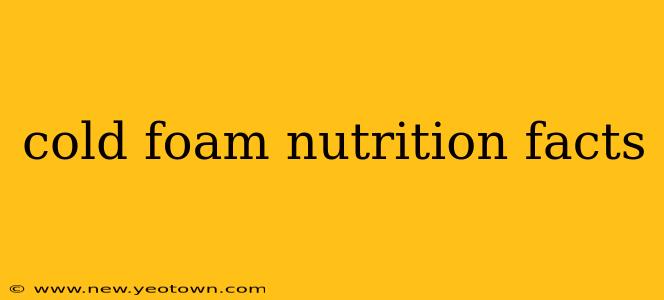Let's be honest, the creamy, dreamy texture of cold foam is hard to resist. That cloud-like topping elevates your iced coffee, latte, or even hot chocolate to a whole new level of indulgence. But have you ever stopped to wonder about the nutritional facts behind this popular beverage addition? It's a question many coffee lovers ask, and in this post, we'll dive deep into the world of cold foam nutrition, addressing common concerns and providing you with a clear understanding of what you're consuming.
What is Cold Foam Made Of?
Cold foam's magic lies in its simplicity. The base is usually just whole milk (though some variations use other milk alternatives like oat milk or almond milk), and it gets its signature texture through a process of vigorous shaking or whipping. This aeration incorporates air into the milk, creating that light and fluffy consistency. Sometimes, a touch of vanilla syrup or other flavorings might be added for extra indulgence. The key difference from regular milk foam is the absence of heat; cold foam relies entirely on the physical process of frothing for its texture.
How Many Calories Are in Cold Foam?
The calorie count of your cold foam depends heavily on the type of milk used and any added sweeteners. A typical serving of cold foam made with whole milk, without added sweeteners, generally contains between 20 to 40 calories. This number can climb significantly if you opt for flavored syrups or use a higher-fat milk alternative. Remember that this is just the cold foam; the calories from your coffee or other beverage will add to the overall total.
Is Cold Foam Healthy?
This is a tricky question, as "healthy" is subjective. Plain cold foam made from whole milk offers a relatively small amount of calories and fat, but also some protein and calcium. However, the addition of sugary syrups negates any potential health benefits, significantly increasing the sugar and calorie content. So, the healthiness of your cold foam largely depends on your choices regarding the type of milk and any added flavors. Moderation is key, as with most treats.
What are the Ingredients in Cold Foam?
The beauty of cold foam lies in its minimalist ingredient list. At its core, it's primarily just milk. However, depending on the cafe or your home preparation method, additional ingredients may include:
- Milk: Whole milk is most common due to its higher fat content, which contributes to the creaminess. However, alternatives like oat milk or almond milk are becoming increasingly popular.
- Sweeteners: Vanilla syrup is a popular choice, but other flavored syrups or even simple sugar can be added. This impacts the calorie and sugar content significantly.
- Flavorings: Beyond vanilla, you might find options like cinnamon, caramel, or other extracts, each adding its own caloric and nutritional profile.
Is Cold Foam Good for Weight Loss?
If you're aiming for weight loss, cold foam may not be your best friend, especially if loaded with sweeteners. While the plain version isn’t overly calorific, it's still an added source of calories and fat that could hinder weight loss efforts. Choose low-fat or non-dairy milk alternatives and avoid excessive sweeteners to minimize the impact on your calorie intake.
How Much Fat is in Cold Foam?
The fat content of cold foam primarily depends on the milk used. Whole milk will contribute more fat than skim or non-dairy options. A typical serving of cold foam made with whole milk might contain around 2-4 grams of fat.
What are the best milk alternatives for cold foam?
Several milk alternatives work well for making cold foam, each with its own unique flavor and texture profile. Oat milk is a popular choice for its creamy texture and slightly sweet flavor, while almond milk can offer a lighter, less dense foam. Soy milk and coconut milk are other options, though the resulting foam may have a different texture than what is achieved with whole milk. Experiment to find your favorite!
In conclusion, cold foam's nutritional profile is highly customizable. By carefully choosing your milk and avoiding excessive sweeteners, you can enjoy this delightful treat without significantly impacting your health goals. Understanding the ingredients and their nutritional implications empowers you to make informed choices and savor every sip responsibly.

